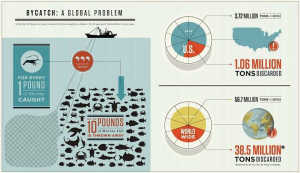Bycatch is defined as unwanted fish and other marine species caught during marine fishing intended for a different species. Species of all types are affected by this, including turtles, dolphins, porpoises, and sharks, among others. The process of being caught can kill these species directly, or after being released again, they are often injured or too weak to survive. Even when regarding fish that would have been commercially viable, many times they are caught and discarded due because they are too young and too small. As a result, they typically do not survive either.

The current U.S. laws about fisheries try to address this issue, as some regulations have been put in place. The official guidelines are described here:
“Wild-capture marine fisheries in the United States are conducted under science-based fishery management plans developed by regional fishery management councils through an open, public process, and using the best scientific information available. By law, U.S. seafood must be caught according to fishery management plans that:
- Consider social and economic outcomes for fishing communities.
- Prevent overfishing.
- Rebuild depleted stocks.
- Minimize bycatch and interactions with protected species.
- Identify and conserve essential fish habitat.”

The official fishery guidelines say the following about bycatch:
“Conservation and management measures shall, to the extent practicable, (a) minimize bycatch and (b) to the extent bycatch cannot be avoided, minimize the mortality of such bycatch.”
While this is a positive step the U.S. is taking, these guidelines have not mitigated the issue of bycatch to the degree it should be. It is best to find seafood from places that go above these regular and vague requirements.
Luckily, there are steps that can be taken to put an end to bycatch. Sustainable fisheries ensure they prevent bycatch as much as possible, so sponsoring them by purchasing their seafood puts pressure on regular fisheries to adopt anti-bycatch practices as well. Typically, this consists of adopting fishing tactics that are more selective in nature. Longlines can stretch for miles, so changing the length of these fishing devices can lessen the amount on non-target species caught, as can changing the size and shape of hooks and bait.
It is crucial we support sustainable fisheries by purchasing responsibly sourced seafood.
Images from:

